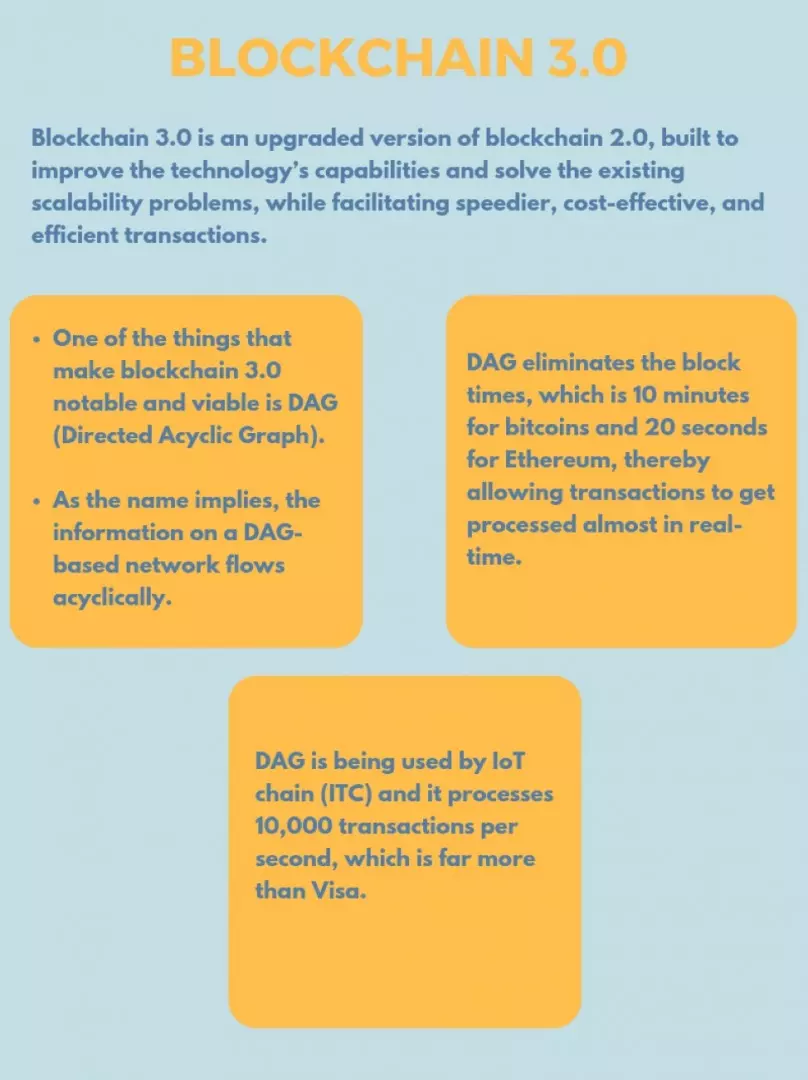Blockchain 3.0 targets to address the scalability, sustainability, cost, interoperability, and security related dilemmas that we had with blockchain 1.0 and 2.0, promising better solutions with a refined framework.
Before we give you concrete details about blockchain 3.0, we will first have to make you understand what dragged blockchain experts to think about blockchain version upgradation? To know why, we will have to go back to the time when Satoshi Nakamoto wrote a whitepaper on bitcoin back in the year 2009. This was when blockchain 1.0 came into existence. The excitement around bitcoins grew tremendously then. The concept that any middlemen do not back this digital currency (read, government), unlike fiat currencies, grabbed everyone’s attention. More to it, everyone was thankful for the underlying technology, blockchain, that facilitated a secure, efficient, and transparent environment for carrying transactions, cutting down the middlemen and double-spending. But a common question, where do this extraordinary cryptocurrency come from, arose? For bitcoins, miners have to solve a highly complex math problem, so difficult that it is impossible to solve the problem by us. Hence, miners had to use high-powered computers, and the likelihood of the problem getting solved was 1 in 7 trillion. Beyond the wastage of resources, bitcoins possessed scalability issues, having transaction processing speed capacity between 3.3 and 7 transactions per second. Soon, the limitations were taken into consideration, which was why professionals launched blockchain 2.0. In this version, we saw Ethereum bragging its transaction processing speed, which is roughly 15 transactions per second (double of bitcoins TPS). Blockchain 2.0 saw the birth of smart contracts, computer programs that execute autonomously when a predefined condition meets, staying on the blockchain network. Though the second version was far better and quicker than the first version, it tremendously failed really to meet the pace of the centralized payment mediums like Visa and PayPal (how is explained later). Both the versions were an unfeasible, unsecured (remember 51% attack?), and expensive solution. And, such a serious situation opened opportunity doors for blockchain 3.0. Let's see what Blockchain 3.0 is.
Introducing Blockchain 3.0

While the second version was better than the first, blockchain communities cannot just ignore the success stories of giant centralized players, Visa and PayPal. Visa can handle on average around 1,700 transactions per second, while PayPal can handle around 10 million transactions per day.” Hence, the need was to make blockchain a feasible technology for fintech players. And for this to happen, the scalability issues had to be first considered and solved. Blockchain 3.0 is an upgraded version of blockchain 2.0, built to improve the technology’s capabilities and solve the existing problems, while facilitating speedier, cost-effective, and efficient transactions. One of the things that make blockchain 3.0 notable and viable is DAG (Directed Acyclic Graph). Let’s first understand the logic behind the data structure, DAG. As the name implies, the information on a DAG-based network flows acyclically. So, this means that the information cannot be sent back to the sender. The information will flow in only one direction. It makes sure that nodes are not connected to any previous ones. Such a structure eliminates the block times, which is 10 minutes for bitcoins and 20 seconds for Ethereum, thereby allowing transactions to get processed almost in real-time. DAG is being used by IoT chain (ITC) and it processes 10,000 transactions per second, which is far more than Visa.
Blockchain 3.0: The Newcomers Welcomed
As Blockchain 1.0 and Blockchain 2.0 tremendously failed in its endeavors to gain mass confidence, we have a new era of the technology waiting for us to embrace it - BLOCKCHAIN 3.0.Cardano - Spearheaded by Charles Hoskinson (one of the co-founders of Ethereum), Cardano is an advanced blockchain platform, that includes smart contracts, transaction systems, and Dapps, developed out of scientific philosophy and high-level research. Pioneering an altogether new approach for digital currencies, Cardano is leading the charge of Blockchain 3.0. Let’s see how Cardano is better than Ethereum.
- Cardano uses Haskell programming language, whereas Ethereum uses Solidity. Haskell is a universally accepted programming language with non-strict semantics, whereas Solidity is a contact-oriented language explicitly built for writing smart contracts. Haskell enables developers to write codes precisely, enabling them to establish efficient and secure protocols. Solidity, on the other hand, possess serious security issues.
- Cardano uses a proof of stake consensus mechanism, whereas Ethereum uses proof of work. Instead of miners wasting their resources for computing the math problem, the POS system relies on factors such as the wealth of the creator and complexity levels in the network at that time. POS consensus mechanism not only saves energy resources but also reduces the risks of 51% attack (because, an attacker trying to purchase 51% of coins will automatically see the coin’s cost appreciation).
EOS - EOS is a blockchain platform that works similar to that of the second generation of Blockchain, Ethereum. It aims to build a complete decentralized operating system for the evolution of Dapps and smart contracts. Intended specifically to remove transaction fees and process millions of transactions per second, EOS blockchain seems like it truly understands what the public really wants. In their pursuit to conduct more transactions, EOS blockchain uses distributed Proof of Stake consensus mechanism, thereby eliminating the scalability dilemma. Let's give a simple example of how EOS visions to work. Take for example you are traveling by cab. Once you reach your destination, you give fiat cash to the cab driver for the service. But with EOS the case will be different. You will have to pay the cash before boarding. Once you reach the destined place, the driver will return your cash back.
Blockchain, being truly a revolutionary, disruptive technology has not yet gained mass confidence. Gartner’s report is a proof for the statement made. For all who think that the technology is just a fad, wait for the time when this new version of the technology, Blockchain 3.0, reaches the mainstream. Since blockchain’s inception, the technology is rapidly evolving through new iterations, despite people’s increasing skepticism. Talking practically, technology success cannot be achieved overnight. And to open the door of success, blockchain developers will have to climb the stairs of efforts. In this endeavor, they have to follow the continuous loop of:
- researching (new ways or approaches to solving pain points),
- studying (to learn whether the identified approach will work or not),
- planning (building a strategy for implementation),
- implementing and experimenting (experimenting with the new methods),
- testing, and
- benchmarking (setting realistic and challenging goals).
that will lead them to the right path of success. Looking at the pace at which experts are attempting to make the technology flawless shows signs that we are nearing a brighter decentralized future.




Leave your comments
Post comment as a guest